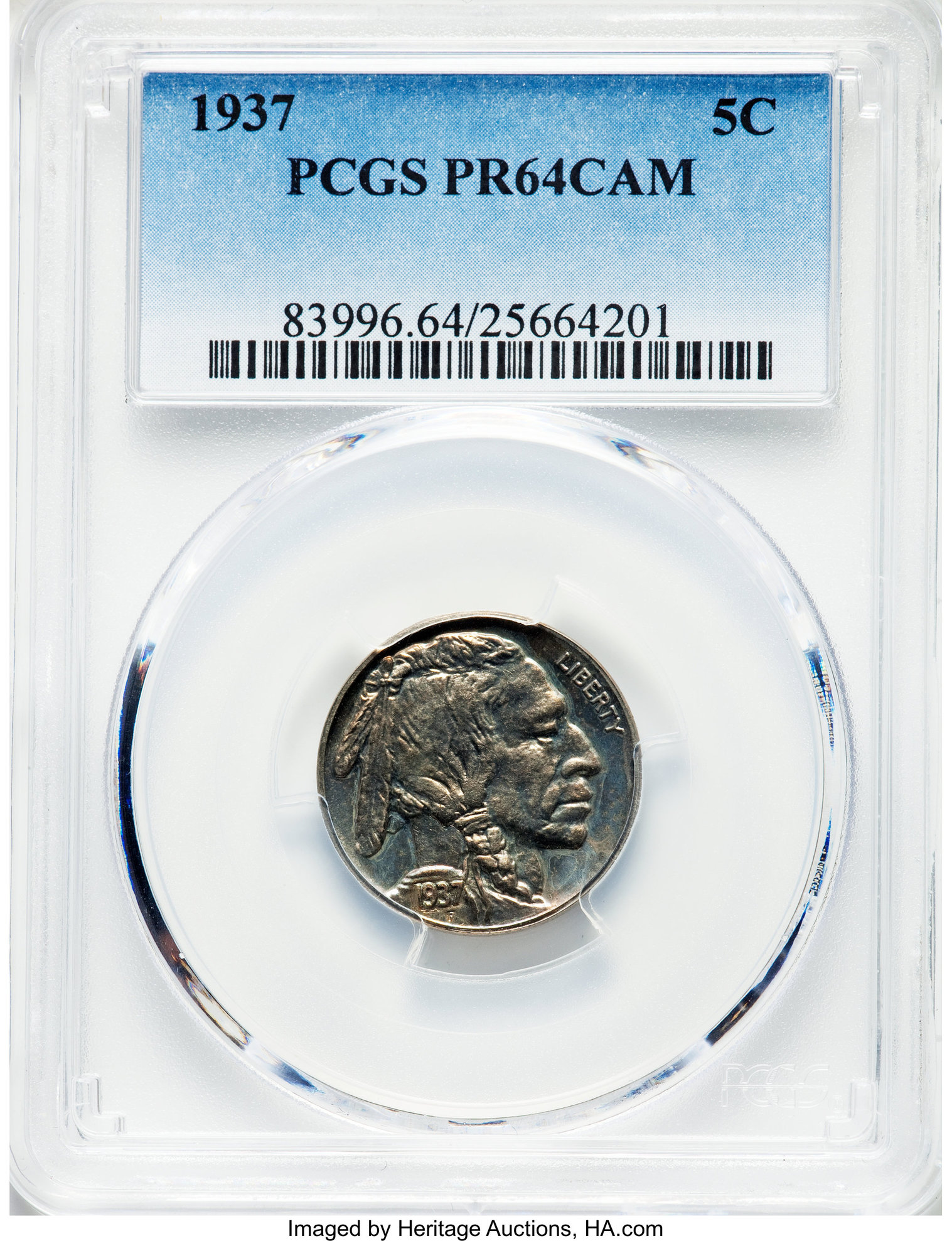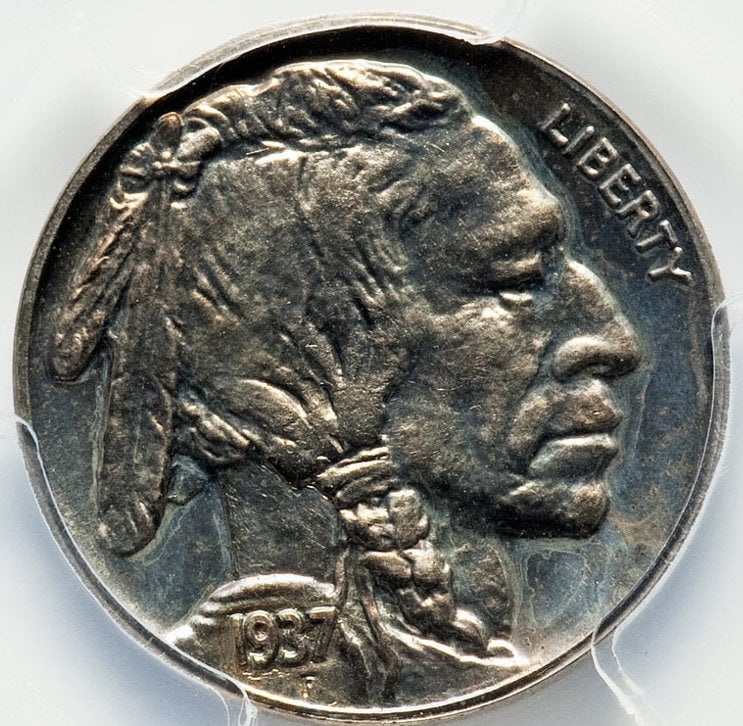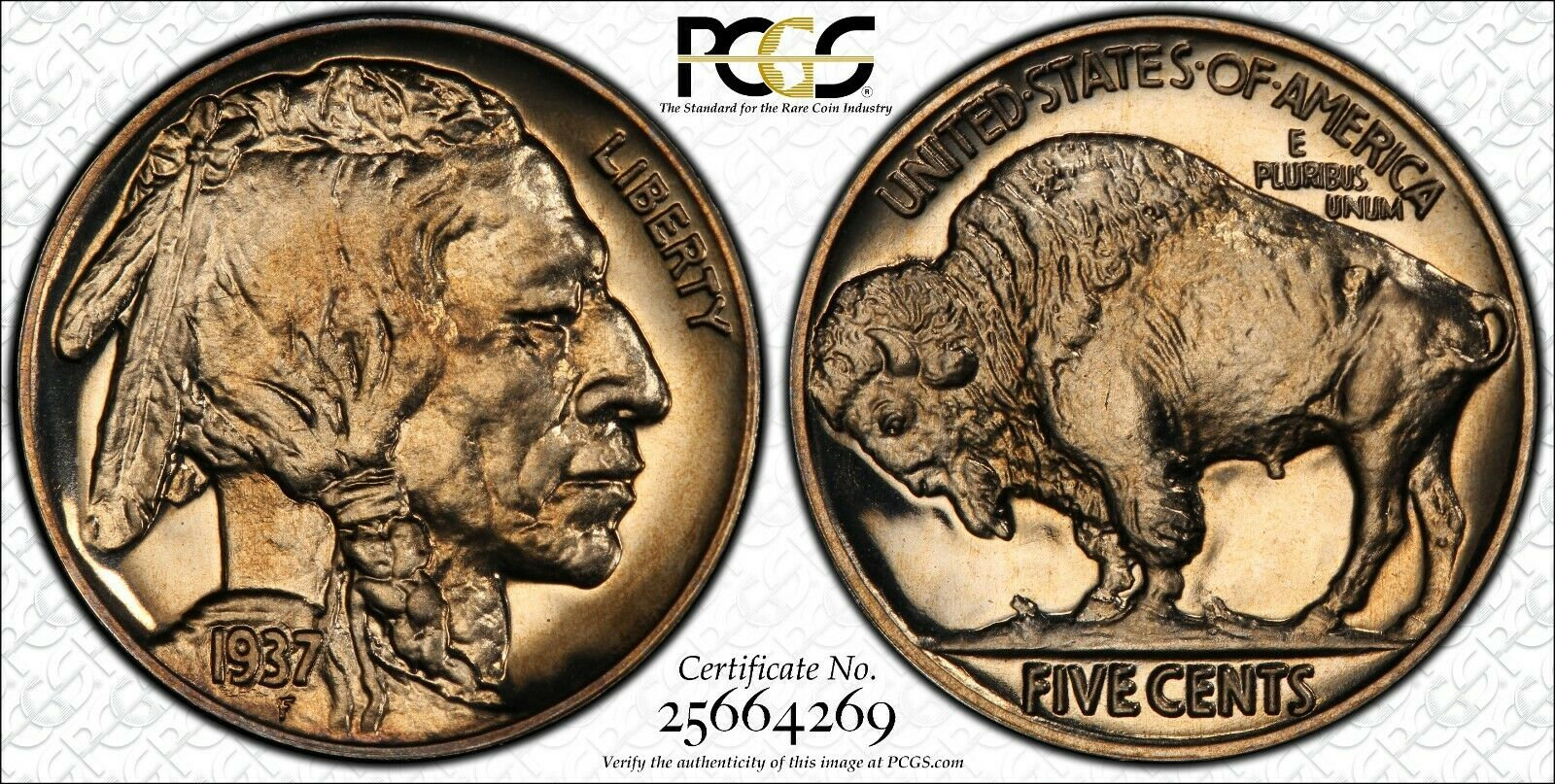1937 cameo proof buffalo nickel -- with problems.
 BUFFNIXX
Posts: 2,740 ✭✭✭✭✭
BUFFNIXX
Posts: 2,740 ✭✭✭✭✭
1937 proof cameo buffalo nickel, PR-64 buffalo nickel, it went for $1560 which aint a lot for a cameo.
Just recently sold in a Heritage auction.
But look at the surfaces. This coin had to have deteriorated in the holder after encasement.
Please note that you can enlarge this picture and then enlarge it a second time by clicking on the plus sign which will show
the coin enlarged. Check out the surfaces of the coin. Upon a second look this appears to be suffering from the results of
multiple dippings/cleanings over time. Just wonder what this coin looked like when the graders got hold of it?

Collector of Buffalo Nickels and other 20th century United States Coinage
a.k.a "The BUFFINATOR"
a.k.a "The BUFFINATOR"
1
Comments
Is it my eyes, the slab, the coin, or a combination?
There appears to be a “film” of something along the periphery of the Indian bust relief.
Reminds me of soap scum or when you fail to properly rinse your windshield/windows on your truck after a good sudsy wash.
.

Reminds me of the "look" that artificially frosted coins took on months/years after grading. Most of this happened about 15 years ago. I had to sent 3 or 4 coins to PCGS for review - they were great to work with.
A foreign substance was applied to the surface of the devices to give them a cameo appearance. Good enough to fool PCGS and me, but ultimately they changed in the holder. Often you saw a bluish haze on the devices that sometimes bled into the fields over time, but not as much as in this example.
I am sure a good search of the forum will reveal several interesting threads on this topic.
“In matters of style, swim with the current; in matters of principle, stand like a rock." - Thomas Jefferson
My digital cameo album 1950-64 Cameos - take a look!
For some reason👃grease comes to mind. @Insider2 brought me to understanding (somewhat) what that was all about.
So sad for the coin.
the second photo provided by @LanceNewmanOCC is of the same coin as first posted by me above.
This photo of the obverse goes with the one I first posted, it is the same coin. Heritage posted this second photo after I pointed out to them that the coin really looked like it had problems. What the second photo does is minimize the field disturbances but highlights the 250 or so obverse spots the coin has! So the second picture is really not any better than the first. OK I will grant you that the second picture does present the coin in a better light but, as the saying goes
“You cannot put lipstick on a...........”
And after reading Cameonut’s post above I wonder if this coin may have been doctored to add the cameo frost and then it
got past the grades at pcgs and into a cameo holder. Looking at the picture for cameo frost I do not see much if any evidence of it.
a.k.a "The BUFFINATOR"
Wow... those are the same coin?? Amazing.... I have less and less faith in coin pictures.... That being said, the coin is obviously different than when it originally slabbed... at least I think so. Cheers, RickO
Old dipping or perhaps PVC? Either way, yuk!
My YouTube Channel
Well -- still to high a price for a damaged/dipped/soaped/dried-up coin. That one begs for professional conservation to prevent further damage.
That is a liquid chemical residue. IMO, Heritage should send it to PCGS and let them fix it.
Wow, excellent example of the "tricks" that lighting can play on our eyes. FLORESCENT LIGHT would have shown the spots AND the chem flow. That's why it is the only light recommended for authentication! Oh, and one of the lights to use for grading along w/a 75W-100W incandescent light.
That coin can be conserved and no one would be the wiser.
Are you suggesting those spots would not show under anything other than florescent light?
Hopefully (for my ego at least lol) the above question will clarify things, because my experience is that spots show just fine regardless of light. Now, chemical flow is another story, and I would agree, but not when it comes to spots on Buffs -- in my experience (which is surely less than your own) they show really well no matter the light type.
Taken together, this makes me suspect the spots in the 2nd shot that Lance posted showed up (or got worse, as I can spot a few spots in the first set, but not nearly all of them) at a different time than the chem flow that showed in the 1st group.
Curiously yours....Mike
Wow! That is a leopard for sure. I too, don't see the cameo in either photo and would have not guessed they were the same coin until your post. Thx BUFFNIXX
I saw this coin in hand about 3-4 years ago, and I was not impressed. The contrasts were also weak, and I recall thinking it was not worth the premium at the time IMHO.
You might be on to something. I don't recall the film/haze when I saw it a few years ago, but I am 100% it is the same coin based on the spotting and toning around the date.
Sorry, but I'm not a fan of it !!!
So what @Insider2 is saying is that this coin could (may well have been) to pcgs for conservation and then reslabbing at the same proof-64 cameo grade. Of course this presupposes that the cameo is not an artificial job. Just looking at the pictures does not appear to be a full cameo anymore. Are you sure that coins like this can be conserved to the point that no-one could tell it was messed with in the first place? I doubt that but I am not a professional “conserver”.
Since the “winning” bider paid about $1500 for it, the coin may well be a candidate for conservation. But I think that once this is done it aint a going to qualify for a cameo designation.
I find it hard to believe that the coin pictured below could be conserved and then come out as PR64 cameo!

a.k.a "The BUFFINATOR"
A complete set of proof buffalo nickels consists of.....
1) 1913 type one
2) 1913 type two
3) 1914
4) 1915
5) 1916
6) 1936 satin
7) 1936 brilliant
8) 1937 brilliant
To these eight you could add the following two
7a) 1936 satin-brilliant (kind of a hybrid between satin and brilliant.
8a) 1937 brilliant - cameo
7a) above is not well known but they do exist.
In another post I have wondered why pcgs has not slabbed any 1936 brilliant-cameo specimens.
Any comments?
a.k.a "The BUFFINATOR"
Here is a 1937 pcgs pr67 CAMEO on eBay right now. Really a nice coin but I cannot see the cameo.

No problems though.
a.k.a "The BUFFINATOR"
It is often hard to capture the cameo contrasts accurately in a photo for proof coinage of this era. I will say that many of the designated examples aren't super impressive for most denominations, and the examples that are bring nice premiums which is why pricing is all over.
That coin looks like it was dipped and not properly rinsed. I don't know if conservation could help it, but as it is, it's something I would avoid. Proofs a delicate, and it's easy to screw one up, even if it's in a hard metal lke copper nickel.
Dipped. Ruined. Ugly.
Dave
It's probably fixable.
1936 cameo coinage basically doesn't exist except for a handful of cents. When the satin coinage was first made, it was loathed hence the transition to the brilliant finish and excessive die polishing including of the devices. Polishing was so excessive that many 1936-42 coins are missing fine design elements that were polished away. Over polishing of the devices results in no or very few cameo coins.